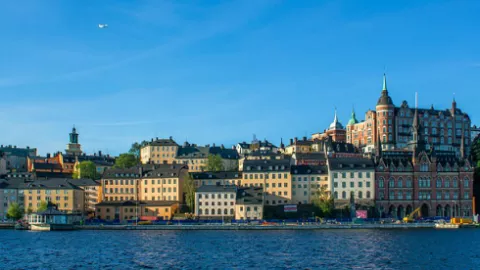
Kerb-free - top 10 accessible European destinations
There are lots of things to think about when travelling with MS. Are the streets flat? Is the public transport easy to access? What about the museums?
We know it takes a lot of planning, so we’ve come up with a list of ten accessible European destinations to whet your appetite. With stunning sights and accessible facilities waiting for you, you’ll be itching to grab your passport…
1. Stockholm, Sweden
Stockholm, pictured above, has taken steps to be barrier free, with the aim of becoming the world’s most accessible city. It’s even started to include accessibility in many of its regulations. The city has now rebuilt pedestrian crossings with access ramps and has a digital pedestrian network that helps those with impaired vision to navigate the city.
2. Berlin, Germany
Berlin’s flat streets and wide pavements make it a top accessible destination. Many buses are fitted with ramps that extend to the kerb, while lots of underground stations are wheelchair-friendly.
Unmissable sights include the Brandenburg Gate and the remaining sections of the famous Berlin wall.
3. Ljubljana, Slovenia
Slovenia’s capital city is another easily accessible city. Think flat streets, a tactile ground system for visually impaired people, dropped kerbs and ramps.
You can reach the castle via the wheelchair-friendly funicular railway, while many of the bridges are accessible too.
4. Stratford-upon-Avon, England
Dropped kerbs and flat pavements make Shakespeare’s hometown a winner for accessibility. As well as this, most of the major sights, including Shakespeare’s birthplace, have good access.
Thanks to buses with lowered disabled access, it’s a breeze to get around this historical town.
5. Dublin, Ireland
Expect delayed traffic lights and easily accessible transport in the Irish capital. There’s plenty of accessible accommodation too, while mostly flat streets mean it’s easy to navigate.
Don’t forget to have a pint of Guinness before you leave though…
6. Milan, Italy
Not only has Milan improved accessibility around the city in recent years, it’s also committed to promoting employment for those with disabilities. For this reason, it won the EU Access City award 2016.
Wondering what to see? Take a trip to the Duomo and then visit da Vinci’s Last Supper.
7. Barcelona, Spain
From the relatively flat streets to the 100% accessible bus system, it’s no wonder that we’ve included Barcelona on our list.
Dropped kerbs are spread throughout the city and many tourist buses are even equipped with ramps too.
Admire Gaudi’s modernist architecture and visit the home of Barcelona’s football team at the Nou Camp in the Catalan capital.
8. Vienna, Austria
Vienna has made great efforts to be a barrier free city. Cobblestones have been removed and low-floor vehicles operate on almost all streetcar and bus lines.
Lifts and ramps mean wheelchairs can also access most underground stations.
9. Munich, Germany
The picturesque German city aims to make journeys “as easy as possible” for people with all levels of mobility. You’ll find low-floor buses, dropped kerbs and barrier-free access to every underground platform.
The BMW museum is a must-see – and it’s suitable for wheelchairs.
10. London, England
No list of accessible cities would be complete without London town. The public transport network is taking large strides to become fully accessible, and all 8,000 London buses are equipped with low floors to allow access. Plus, all black cabs are wheelchair friendly – a rare achievement across European cities.



